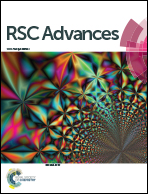Microwave-assisted synthesis of ortho-substituted diaryl N-(tert-butylsulfinyl)ketimines†
Abstract
A simple and efficient procedure for the synthesis of ortho-substituted diarylketimines has been developed under microwave irradiation, employing the corresponding diarylketones and (R)-(+)-tert-butylsulfinamide in the presence of Ti(OiPr)4. This approach allows the preparation of most final ketimines (3a–g) containing electron-donating groups in good yields in 1 h. For starting materials with strong electron-withdrawing groups, the desired (3h–m) products could also be prepared by increasing microwave energy and extension of the reaction time to 2.5 h.


 Please wait while we load your content...
Please wait while we load your content...